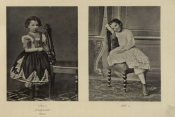
The Presidential Library marking the 170th anniversary of actress Maria Savina
For forty years Maria Gavrilovna Savina (1854–1915) shone on the stage of the Alexandrinsky Theater in St. Petersburg. She devoted most of her life to the theater, living in the theater and for the theater. The Presidential Library's collections feature numerous documents, letters, biographical sketches and photographs of the actress, including the unique photo album “Honored Artist of the Imperial Russian Drama Troupe M. G. Savina. Thirty-five years on the Imperial stage" (1909).
Maria Gavrilovna was born on April 11 (March 30, old style) 1854. The love for acting was passed on to her from her father, Gavriil Nikolaevich Podramentsov. He worked as an art teacher in a gymnasium and often performed in the theater as an amateur actor, but eventually stopped teaching and devoted himself entirely to the stage. Maria received her primary education in Odessa, where at the age of eight she played her first role in the drama “Esmeralda”.
Maria Gavrilovna began performing on stage early. As a teenager, she and her father wandered around the cities of the deep provinces from theater to theater. She traveled, if not all, then probably half of Russia. Before shining as a bright star on the stage of the Imperial Alexandrinsky Theater in St. Petersburg, Maria Gavrilovna appeared on stage in Kaluga, Smolensk, Nizhny Novgorod, and Orel.
Russian writer and playwright Evtikhiy Karpov first saw the young provincial actress Savina on the stage of the Oryol Theater in 1872, when as a boy he secretly ran to performances from his parents. Then he could only watch her from the auditorium, but after 18 years fate brought them together again. He is a young playwright, she is an already famous actress who will play the main role in his play. This time they met in person.
Cheerful, energetic, infectiously cheerful, full of spontaneous, bright comedy and subtle humor, graceful, she came to the stage of the Imperial Alexandrinsky Theater in 1874. The Presidential Library's collections provide the “Case of the Service of the Honored Artist Maria Savina” which began on August 19, 1874, and ended on September 8, 1915. The very first entry is a petition from the young artist Savina to the Directorate of the St. Petersburg Imperial Theaters for employment. This “work book” has more than a thousand pages, preserving all the events that happened to the actress at the Alexandrinsky Theater, to which she devoted 41 years.
None of the actresses on the Alexandrinsky stage of that time had such amazing energy and ability to work, such a skillful ability to work on roles, as Savina. She felt the era, transformed into her heroines - she lived and thought like them. Verochka from I. S. Turgenev’s play “A Month in the Village” as portrayed by Savina, completely transported the viewer to another time. The production of this play marked the beginning of a tender friendship between the young actress and the elderly Turgenev.
Turgenev played a special role in her life. The Presidential Library's collections present materials for the book “Turgenev and Savina”. They include a portrait of Turgenev dear to Savina’s heart, a photograph of the bracelet that the writer gave to the actress, as well as a photograph of another very valuable Turgenev gift for Maria Gavrilovna - this is a “blue book” for recording memories. Later in this book, Maria Gavrilovna will describe how she met Ivan Sergeevich.
Ivan Sergeevich Turgenev more than once recalled with warmth the stay of M. G. Savina in 1880 at his estate Spasskoye-Lutovinovo. Maria Gavrilovna treasured the writer’s letters like sacred objects.
Savina’s art, her intelligence, and erudition were admired by many modern composers, poets, writers, and artists. She communicated and corresponded with I. A. Goncharov, Ya. P. Polonsky, A. N. Maykov, V. V. Stasov. The library's collections include her letters and notes to the playwright and theater critic Yuri Dmitrievich Belyaev (1876–1917).
Maria Gavrilovna was an integral and very active person. She devoted her free time from the theater to organizing charity performances and participated in them herself. Proceeds from such productions went to benefit sick comrades and families of the deceased. She knocked on the doors of influential people asking for relief from the plight of those whose crime against the law was caused by their living conditions.
In St. Petersburg in 1895, Maria Gavrilovna Savina founded a Shelter for Elderly Stage Workers in memory of Emperor Alexander III, which was administered by the Russian Theater Society. Initially, the society accepted the actors in its own house on Kirochnaya Street, where residents received full board. A year later, the society was given a small plot of land on Petrovsky Island on the banks of the Malaya Nevka for free use to create a Shelter for Elderly Artists.
Every year, Maria Savina dedicated the first day of Christmas to charitable institutions. At dusk, a Christmas tree was held for the children of the shelter and boarding house, with the distribution of gifts and all kinds of children's entertainment, and then for the “boarders of the shelter” - a literary and musical evening.
In addition to living rooms and auxiliary premises, a church was built in the building in the name of St. Nicholas the Wonderworker. Subsequently, Maria Savina and Anatoly Molchanov were buried in the crypt under the altar of this church. After the 1917 revolution, the Shelter for Elderly Artists in memory of Emperor Alexander III was renamed the House of Stage Veterans.
In 1931, the House of Stage Veterans was named after Savina in honor of the 50th anniversary of her death, and in 1965 Savina Street appeared on Petrovsky Island next to this house.
Today, the cultural heritage site “House of Stage Veterans named after M. G. Savina (boarding house)" is administered by the Administrative Directorate of the President of the Russian Federation. Here, on Petrovsky Island, accommodation and medical services are organized for former workers of theaters and theatrical institutions.









